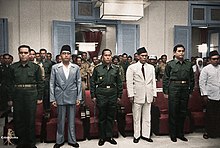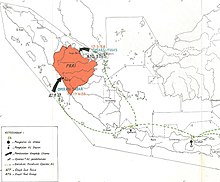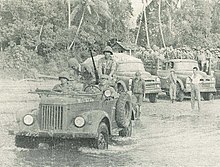| Revolutionary Government of the Republic of IndonesiaPemerintahan Revolusioner Republik Indonesia | |||||||||
|---|---|---|---|---|---|---|---|---|---|
| 1958–1961 | |||||||||
 Flag
Flag | |||||||||
 Indonesian Navy military operations against PRRI in Central Sumatra in 1958 Indonesian Navy military operations against PRRI in Central Sumatra in 1958 | |||||||||
| Status | Unrecognized revolutionary government | ||||||||
| Capital | Padang | ||||||||
| Language | Indonesian | ||||||||
| Government | Parliamentary republic | ||||||||
| Prime Minister | |||||||||
| • 1958–1961 | Sjafruddin Prawiranegara | ||||||||
| Historical era | Cold War | ||||||||
| • Established | 17 February 1958 | ||||||||
| • Disestablished | 28 September 1961 | ||||||||
| |||||||||
| Today part of | Indonesia | ||||||||
The Revolutionary Government of the Republic of Indonesia (Indonesian: Pemerintahan Revolusioner Republik Indonesia, abbr. PRRI) was a revolutionary government set up in Sumatra to oppose the central government of Indonesia in 1958.
Although frequently referred to as the PRRI/Permesta rebellion, the Permesta rebels were a separate movement in Sulawesi, that had pledged allegiance with the PRRI on 17 February 1958.
Background: Rebellion of the colonels
Prior to the establishment of the PRRI, there were several "rebellions" led by the various regional Army commanders in Sumatra. These events were the result of growing dissatisfaction with the Central Government and Indonesia's faltering economic development. The Central Government was seen by some in the outer islands (i.e. outside of Java) as disconnected from the Indonesian people. Some Army commands in the outer islands began covert smuggling operations of copra and contraband items to improve their financial position. These operations were soon followed with requests for greater economic and political autonomy from the Central Government in Jakarta. After their demands were not met they began to rebel against the government, conducting a series of bloodless coups within their regional command areas, and setting up alternative local government systems. The rebel army commands included:
- Dewan Banteng (Banteng Council) in Central Sumatra which on 20 December 1956 under the leadership of Lieutenant Colonel Ahmad Husein (Commander of the 4th regiment of the Territorial Army in Sumatra) began to take over the local government of Central Sumatra.
- Dewan Gajah (Elephant Council) in East Sumatra which on 22 December 1956 under Colonel Maludin Simbolon (Supreme Commander of the Territorial Army in Sumatra) began to take over the local government in East Sumatra and cut all relation with the Central Government.
- Dewan Garuda (Garuda Council) in South Sumatra which on 15 January 1957 under Lieutenant Colonel Barlian took over the local government of South Sumatra.
- Dewan Manguni (Manguni Council) in North Sulawesi which on 20 December 1956 under Lieutenant Colonel Ventje Sumual took over the local government of North Sulawesi.
Governor Roeslan, who yielded powers to Lieutenant Colonel Ahmad Husein, said that:
"The Banteng Council in particular and the people of Central Sumatra in general have no wish to build a State within a State, because relations between the Regional and the Central Government of the Republic of Indonesia will certainly return to normal when there is a Cabinet that can eliminate all the feelings of confusion, tension and dissatisfaction that threaten the security of the Indonesian State and People."
Ultimatum
The PRRI was proclaimed to have been established on 15 February 1958 by Lieutenant Colonel Ahmad Hussein following the expiration of a five-day ultimatum to the government. The ultimatum demanded for three things. First, for the Djuanda Cabinet to return its mandate. Second, for Mohammad Hatta and the Sultan of Yogyakarta (Hamengkubuwono IX) to form a cabinet until a future election. Third, for President Sukarno to return to his constitutional position.
Following the declaration, a number of government officials sent to negotiate with the Banteng Council in Bukittinggi were detained, including Minister of Agriculture Eny Karim.
Members of the PRRI cabinet

The Revolutionary Government of the Republic of Indonesia formed a cabinet for the revolutionary government, with Sjafruddin Prawiranegara being named as both its prime minister and finance minister.
The composition was as follows:
| Position | Name |
|---|---|
| Prime Minister | Sjafruddin Prawiranegara |
| Ministry of Foreign Affairs | Maludin Simbolon |
| Ministry of Internal Affairs | Assaat Dt. Mudo |
| Ministry of Defence | Dahlan Djambek |
| Ministry of Security and Justice | Burhanuddin Harahap |
| Ministry of Communications | Sumitro Djojohadikusumo |
| Ministry of Finance | Sjafruddin Prawiranegara |
| Ministry of Telecommunications and Postal | Dahlan Djambek |
| Ministry of Trade | Sumitro Djojohadikusumo |
| Ministry of Information | Saleh Lahade |
| Ministry of Development | J. F. Warouw |
| Ministry of Social Affars | Ayah Gani Usman |
| Ministry of Education | Muhammad Sjafei |
| Ministry of Health | Muhammad Sjafei |
| Ministry of Religious Affairs | Muchtar Lintang |
| Ministry of Labour and Agriculture Affairs | Saladin Sarumpaet |
Challenges
Despite the various stakeholders who had appeared to all be on the same side of resisting Central Government control to some extent, the declaration of the rebel government and the open split from the Central Government in Jakarta had immediately highlighted that not all parties were willing to take things to such an extreme. One of these unwilling parties was the Garuda Council led by Lieutenant Colonel Barlian. Even within Lieutenant Colonel Ahmad Hussein's Banteng Council, there were key leaders and segments who opposed the establishment of the PRRI. The lack of alienation from the political order of that time also meant that there was no real support or traction on the ground at all for such an open rebellion.
Giving no slack to the PRRI, the Central Government in Jakarta also moved decisively against the PRRI, arresting several of the named cabinet ministers, discharging from service military commanders who supported the PRRI and bombing key infrastructure in Sumatra.
Armed conflict
PRRI Rebellion
| PRRI Rebellion | |||||||
|---|---|---|---|---|---|---|---|
| Part of the Permesta–PRRI rebellion, Cold War in Asia, and the CIA activities in Indonesia | |||||||
 | |||||||
| |||||||
| Belligerents | |||||||
|
|
Supported by: | ||||||
| Commanders and leaders | |||||||
|
|
| ||||||
| Casualties and losses | |||||||
|
1,031 dead
Total: 3,702 killed, 5,228 wounded, 1,242 missing (include casualties in PRRI and Permesta rebellion) |
6,115 dead
| ||||||
|
5,592 civilians killed | |||||||
The central government saw PRRI as a separatist movement that had to be crushed by force of arms. The central government through the Angkatan Perang Republik Indonesia (APRI or nicknamed "tentara pusat/the central army") conducted a joint operation consisting of Army, Navy, and Air force. The operation that was carried out was Operation Tegas [id], Operation 17 Agustus, Operation Saptamarga [id], Operation Sadar [id], Operation merdeka [id]
In the early stages of the military operation, government administration activities were paralyzed, officials and employees fled in order to save themselves. To revive the government, the central government divided Central Sumatra into three provinces, one of which was West Sumatra. On May 17, 1958, Kaharuddin Datuk Rangkayo Basa was appointed as the first Governors of West Sumatra.
On the other hand, the actions of the central army are running out of control. APRI soldiers committed acts of violence. Thousands of people suspected of being PRRI sympathizers were arbitrarily arrested. Actions of mass killings occurred in a number of places. Under the Jam Gadang, APRI killed around 187 people by shooting. Only 17 of that number were PRRI soldiers, while the rest were civilians. The corpses were then lined up in the courtyard of the Clock Tower.
From mid-April 1958 to 1960, all junior and senior high schools were closed. Andalas University, which had only been running for two years, was forced to close because almost all of its lecturers and students joined PRRI. Towards the end of 1960, the entire area of West Sumatra was under the control of the APRI army.
Abdul Haris Nasution noted that PRRI military operations claimed the lives of 7,146 people on both sides. Most of those who died, namely 6,115 were "from the PRRI side". Saafroedin Bahar [id] Saafroedin Bahar noted that the number of victims resulting from the short PRRI conflict was far greater than the victims of the war with the Netherlands during the independence revolution.
Apart from military operations, the central government took a diplomatic approach by persuading the PRRI soldiers to surrender and return to loyalty to the Unitary State of the Republic of Indonesia. This event is called Operation Callback. On May 29, 1961, Ahmad Husein officially surrendered along with around 24,500 of his followers. Furthermore, the government granted amnesty to civilian and military elements who had been involved in the PRRI. The amnesty was stated in Presidential Decree No. 322 of 1961 dated 22 June 1961. Although the PRRI leadership responded to the government's call, in reality the promise of amnesty was only rhetoric. For several years, PRRI's civilian and military leadership was quarantined. Communities, especially college students and students, experience heavy life pressures.
Beginning of the end

The Central Government in Jakarta, having tolerated the dissident Army Councils for almost twelve months, promptly began preparations to militarily defeat the PRRI. The rebels had virtually no chance of success given the overwhelming superiority of the government forces. In addition, the military experience possessed by General Nasution, who was leading the government military forces, far exceeded that of Lieutenant Colonel Husein.
The government military campaign that commenced on 12 March 1958 scored a quick victory in preventing the destruction of the Caltex oil fields and refinery in Pekanbaru by the PRRI forces. That attack also laid bare that the PRRI was receiving military aid from the United States, given the large amount of US-made equipment abandoned by the PRRI forces which had taken flight.
The United States Government, especially the CIA (see CIA activities in Indonesia) had covertly supported the rebel PRRI Government in 1958, despite some dissent in the agency from Desmond Fitzgerald. With the Americans posturing to become directly involved in the crisis, General Nasution conducted surprise amphibious assaults on rebel cities in Sumatra during March 1958.
With the military balance swiftly swinging in favour of the Central Government in Jakarta during the period March–May 1958, and the fact that Lieutenant Colonel Husein had little choice but to pursue a strategy of withdrawal and guerrilla warfare which would make it difficult for the United States to publicly recognise the PRRI, the United States had to reconsider its previous policy assessment that the break-up of Indonesia and emergence of a Communist government was likely. The Pope incident on 18 May 1958 signalled the beginning of the end of the CIA's program of covert support to the PRRI, with the US shifting its support back towards Sukarno and the Central Government as the anticipated victor from the conflict.
Surrender
Although the conflict dragged on over the next three years, the government forces were successful in pushing the PRRI into the jungle and mountains, and retook several strongholds, including Kototinggi where the PRRI leadership was headquartered.
General Nasution, who was leading the government forces, launched Operasi Pemanggilan Kembali (Operation Call Back) at the end of 1960 to take advantage of internal rifts within the PRRI. The main objective of which was to persuade the army officers supporting the PRRI to surrender themselves, because once there was no longer military support, the civilians would also follow suit.
Small numbers of PRRI troops began surrendering from April 1961, while the majority did so in the middle of 1961. The last vestiges of the PRRI held out for a few more months before the final surrender by Mohammad Natsir, who was the last of them, on 28 September 1961.
Legacy

One of the most significant outcomes of the conflict was the establishment of Foreign Relations of the Soviet Union to the Indonesian Government. As the crisis had unfolded, the Indonesian Government had approached the American Government for arms to combat the rebel commands. The Americans, however, had declined the Indonesian request, forcing the Indonesians to approach the Soviet Union for assistance. The Soviet Union thus became a major supplier of arms to the Indonesian Government, allowing Indonesia to rapidly modernize its armed forces into one of the strongest in Southeast Asia. This had follow on effects in the West New Guinea dispute as Indonesia was able to escalate tensions in the dispute by threatening overt conflict.
Another important aspect was the influence of this event on the large exodus of Minangkabau people from Sumatra to other regions in Indonesia, along with the large psychological effects that stem from the attached stigma of being a rebel, despite the Minangkabau's determined resistance against the Dutch colonial system and the fact that many pre-Independence nationalistic leaders had hailed from Sumatra. In addition to the violence committed against the local community during and after the conflict period, the humiliation and trauma of the defeat had also rocked the self-esteem and dignity of the Minangkabau people. This was especially stark In an interview with Harun Zaid, where he said "What had an impact on me was the sadness in the eyes of the students. In 1961, the faces were dull as if they did not have any future".
References
- (former Finance Minister and Prosperity Minister, head of state of Indonesia in 1948–1949)
- (Preceded by Colonel Dahlan Djambek prior to Assaat's arrival in Padang) (former president of the Republic of Indonesia during the United States of Indonesia period)
- Audrey R. Kahin and George McT. Kahin, Subversion as Foreign Policy: The secret Eisenhower and Dulles debacle in Indonesia, p. 143
- M.C. Ricklefs, A history of modern Indonesia since c.1200, p. 299.
- Poesponegoro. Marwati Djoened, Notosusanto. Nugroho, (1992), Sejarah nasional Indonesia: Jaman Jepang dan zaman Republik Indonesia, PT Balai Pustaka, ISBN 978-979-407-412-1.
- Hasril Chaniago and Kahirul Jasmi. Brigadir Jenderal Polisi Kaharoeddin Datuk Rangkayo Basa. p.227-228
- Audrey R. Kahin and George McT. Kahin, Subversion as Foreign Policy: The secret Eisenhower and Dulles debacle in Indonesia, p. 143.
- Audrey R. Kahin, Rebellion to Integration: West Sumatra and the Indonesian Polity, p. 210.
- Audrey R. Kahin, Rebellion to Integration: West Sumatra and the Indonesian Polity, p. 213.
- Madinier, Rémy (2009). "Lawan dan kawan (Friends and Foes): Indonesian Islam and Communism during the Cold War (1945–1960)". Connecting Histories. Stanford University Press. p. 252. ISBN 978-1-5036-2740-6.
- ^ Audrey R. Kahin, Rebellion to Integration: West Sumatra and the Indonesian Polity, p. 211.
- Syamdani (2009). PRRI, pemberontakan atau bukan? (in Indonesian). Media Pressindo. p. 115. ISBN 9789797880323. Retrieved 28 May 2022.
- Ajip Rosidi, "Sjafruddin Prawinegara: Lebih Takut kepada Allah SWT", p. 212.
- ^ Abrar Yusra (2011).Azwar Anas:teladan dari ranah Minang.Penerbit Buku Kompas.ISBN 978-979-709-585-7.
- Anwar, Rosihan (2006). Sukarno, tentara, PKI: Segitiga kekuasaan sebelum prahara politik, 1961-1965. Yayasan Obor Indonesia. ISBN 978-979-461-613-0.
- Mestika Zed (1995). Sumatera Barat di panggung sejarah, 1945-1995 (in Indonesian). Bidang Penerbitan Khusus, Panitia Peringatan 50 Tahun RI, Sumatera Barat. p. 147.
- Anwar, Rosihan (2006). Sukarno, tentara, PKI: Segitiga kekuasaan sebelum prahara politik, 1961-1965. Yayasan Obor Indonesia. ISBN 978-979-461-613-0.
- Anwar, Rosihan (2006). Sukarno, tentara, PKI: Segitiga kekuasaan sebelum prahara politik, 1961-1965. Yayasan Obor Indonesia. ISBN 978-979-461-613-0.
- Syamdani (2009).PRRI, pemberontakan atau bukan?. Media Pressindo.ISBN 978-979-788-032-3.
- Yusra, Abrar (1997).Tokoh yang berhati rakyat: biografi Harun Zain.Yayasan Gebu Minang. ISBN 978-979-8428-01-2.
- Syamdani (2009). PRRI, pemberontakan atau bukan? (in Indonesian). Media Pressindo. ISBN 978-979-788-032-3.
- Ilyas, Abraham. Syair Kisah Perjuangan Anak Nagari 1958-1961: Kalah di Ujung Bedil Menang dengan Silat (in Indonesian). Lembaga Kekerabatan Datuk Soda. ISBN 978-602-71254-1-4.
- Abrar Yusra (2011). Azwar Anas:teladan dari ranah Minang. Penerbit Buku Kompas.ISBN 978-979-709-585-7.
- Syamdani (2009). PRRI, pemberontakan atau bukan? (in Indonesian). Media Pressindo. ISBN 978-979-788-032-3.
- ^ W. Thomas Smith, Jr. (2003). Encyclopedia of the Central Intelligence Agency. Facts On File/Checkmark Books. ISBN 9780816046669.
- Audrey R. Kahin, Rebellion to Integration: West Sumatra and the Indonesian Polity, p. 215.
- Audrey R. Kahin, Rebellion to Integration: West Sumatra and the Indonesian Polity, p. 225.
- Audrey R. Kahin, Rebellion to Integration: West Sumatra and the Indonesian Polity, p. 226-228.
- Syamdani, (2009), PRRI, pemberontakan atau bukan, Media Pressindo, ISBN 978-979-788-032-3.
- Audrey R. Kahin, Rebellion to Integration: West Sumatra and the Indonesian Polity, p. 229.
Further reading
- Conboy, Kenneth; Morrison, James (1999). Feet to the Fire CIA Covert Operations in Indonesia, 1957–1958. Annapolis: Naval Institute Press. ISBN 1-55750-193-9.
- Doeppers, Daniel (October 1972). "An Incident in the PRRI/Permesta Rebellion". Indonesia (14): 192–195.
- Feith, Herbet and Lev Daniel (Spring 1963). "The End of the Indonesian Rebellion". Pacific Affairs. 36 (1): 32–46. doi:10.2307/2754772. JSTOR 2754772.
- Jaspan, M. A. (Winter 1966). "Indonesia: Counterrevolution and Rebellion". Science & Society. 30: 63–69.
- Kahin, Audrey R.; Kahin, George McT (1995). Subversion as Foreign Policy: The Secret Eisenhower and Dulles Debacle in Indonesia. Seattle: University of Washington Press. ISBN 0-29597-618-7.
- Kahin, George McT (1994). "The Impact of American Foreign Policy". Democracy in Indonesia: 1950s and 1990s (Editors: David Bourchier and John Legge): 63–73.
- Kahin, George McT. (October 1989). "In Memoriam: Sjafruddin Prawinegara". Indonesia (48): 101–105.
| Minangkabau | |
|---|---|
| General history | |
| Culture |
|
| Language | |
| Religion | |
| Tribes and clans | |
| Related organizations | |
